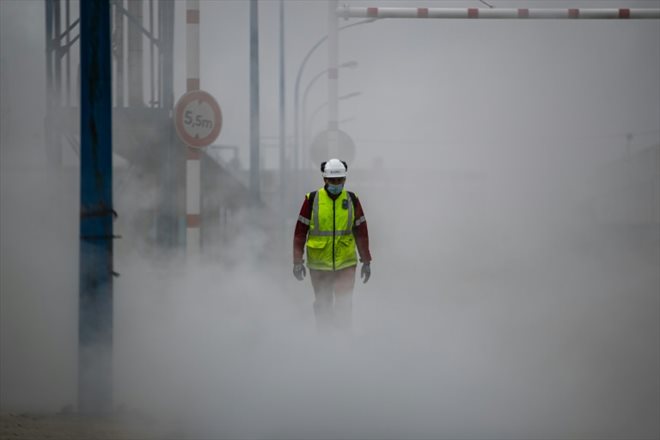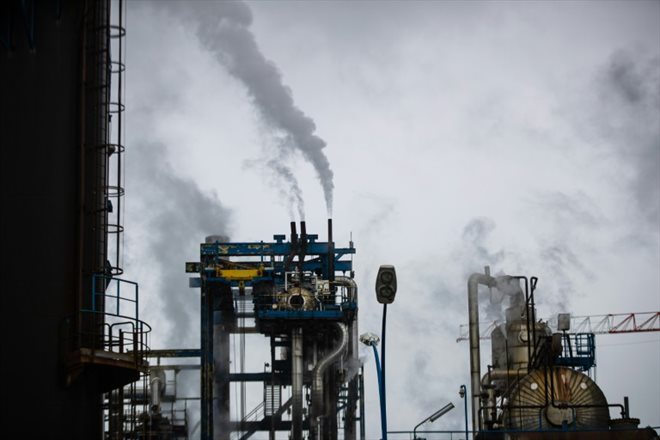The site of the fertilizer giant Yara in Le Havre, April 08, 2022 (AFP/Archives/Sameer Al-DOUMY)
Tank cars loaded with refrigerated liquid ammonia parade on the rails along the Seine: in Le Havre, the factory of the Yara fertilizer group has just restarted. Soaring gas prices after Russia’s invasion of Ukraine forced it to halt production for three weeks.
“We are talking about three, four, five times the price of gas that we knew in the previous months”, explains to AFP Aurélien Rault, head of shutdown and maintenance of the site which belongs to the Norwegian group Yara, first mineral fertilizer producer in the world.
For this group, as for all nitrogen fertilizer manufacturers, the price of gas is decisive: on its own, it accounts for almost 90% of their production costs. At a certain price level, it simply no longer becomes profitable to produce.
At the end of 2021, with the first surge in the price of natural gas in Europe, “40% of European fertilizer capacities were stopped in December”, according to Luc Benoit-Cattin, president of the France Chimie association which brings together the main industrialists in the sector.
The situation in 2022 is aggravated by the Ukrainian conflict, and the price of gas has thus reached “between 100 and 150 euros per MGW depending on the day”, whereas it was on average around 45 euros in previous years, adds Mr. Benoit Cattin.
For its part, Yara decided on March 9 to announce the closure of two sites in Europe, that of Le Havre and its Italian ammonia plant in Ferrara. For the French plant alone, the interruption will lead to a drop of 22,000 tonnes of ammonia production over the year, a hard blow for French farmers who mainly use nitrogen fertilizers, of which ammonia is the basis.
While assuring that he had “never experienced” such a situation, Mr. Rault wants to be reassuring today: prices have come down “in proportions which remain very high on the market, but which remain manageable and allow us to continue to feed the market,” he said.

The site of the fertilizer giant Yara in Le Havre, April 08, 2022 (AFP/Archives/Sameer Al-DOUMY)
In this Seveso-classified chemical site, the forced shutdown of the production lines made it possible to carry out maintenance operations or check data on the condition of the equipment. Each of the 147 employees continued to work.
But it took a total of six days to restart the entire plant and be able to produce the first ton of urea, derived from ammonia. Solid granular urea, of which the Le Havre plant produces 330,000 tonnes per year, is used mainly as a feed supplement for livestock.
– Fertilizers from water? –
Today, at the entrance to the Normandy site, the mouth of the pipeline again spits natural gas — methane whose chemical formula is CH4 — towards the facilities where the gas molecules are “cracked” using water vapor (whose chemical acronym is H2O), before being “synthesized” (mixed) with nitrogen (N) from the air, to produce ammonia (NH3), which is liquefied at -33 degrees to transport it.
Yara is working on solutions to completely do without this mainly imported gas, CH4, which is also the source of greenhouse gas emissions.
During the cracking process to isolate the hydrogen from methane, the carbon molecules (C) combine with those of the oxygen in the water (O2) and produce carbon dioxide (CO2), part of which is reused to produce urea, the other released into the atmosphere.
“Tomorrow, we will be able to extract hydrogen from water, to which we will add nitrogen from the air. This will allow us to produce +green ammonia+ from renewable energies that no longer emit greenhouse gases”, explains Delphine Guey, director of societal commitment at Yara France.

The site of the fertilizer giant Yara in Le Havre, April 08, 2022 (AFP/Archives/Sameer Al-DOUMY)
The fertilizer manufacturer relies heavily on the process of electrolysis of water via green energies (hydroelectric in Norway, solar in Australia, wind in the Netherlands) to supply itself with hydrogen.
“In our production sites in France, we will be able to produce low-carbon fertilizers”, assures Delphine Guey. And “we plan to produce 30% by 2030.”
© 2022 AFP
Did you like this article ? Share it with your friends with the buttons below.




